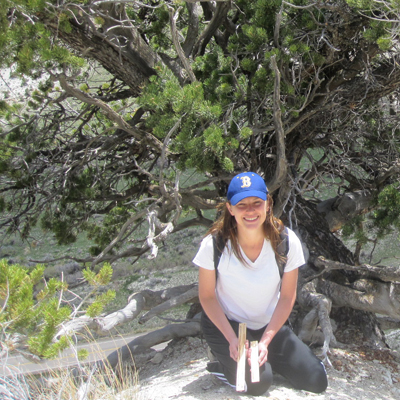To find out what tree rings are telling us about droughts in the Colorado Basin, and to get some current perspective on the current eleven-year drought in the region, listen to my radio story for The California Report and view the slide show of my journey to the region. — Gretchen Weber

Abbie Tingstad is a paleoclimatologist whose doctoral work at UCLA involved reconstructing climate in the Upper Colorado River Basin, using tree rings and lake sediments.
By Abbie Tingstad
Unlike biology, chemistry, or most mainstream sciences, it’s hard to envision what someone who studies paleoclimatology actually does. I run into a lot of blank stares at dinner parties. So I’ve started describing the field as “climate forensics.”
Paleoclimatology and forensics of the Law & Order or Bones variety share the basic goal of reconstructing something that has happened in the past. In the latter, of course, the sequence of events that led to a crime is put together. In the former, researchers identify past variations in climate. These sciences also have quite a lot in common when it comes to the basic methodology:
1. Collection of evidence
I’ll use the example of tree rings, something I have direct experience working with from my research in northeastern Utah. Based on river gauge data, this area of the Colorado River Basin originates 10-15% of Upper Basin water, which is why my colleagues and I were interested in understanding the incidence of past droughts here.
In this case, my climate “fingerprints” were moisture-sensitive Piñon pines. We searched for sites that appeared to have very old living trees — identifiable by trunk size, the open appearance of the branches, and the presence of dead limbs — and lots of dead trees. We used a manual coring device to take pencil-sized samples from both living and dead trees.
2. Lab work
Back at UCLA, I mounted the delicate samples onto wooden holders with an adhesive. Then my assistants and I sanded each sample using progressively finer sandpaper, until individual cells within annual rings were visible under a light microscope.
I counted the annual rings on each of the live samples back in time, starting with the ring closest to the bark. I noted recurring patterns of narrow rings, which are generally associated with climate events unfavorable for tree growth (for example, during the Dust Bowl drought). These patterns allowed me to identify when the dead trees lived. As I had hoped, some of the dead trees were older than any of the living trees, allowing a longer reconstruction.
After dating the samples, I measured the widths of the annual rings using a microscope attached to a computer. I then used statistical software to check the accuracy of my dating and to generate one time sequence per site, based on the ring widths of all the individual trees.
3. Reconstruction of events
In a crime lab, analysts will compare fingerprints, residue samples, or other forms of evidence with a database to place the evidence into context. Paleoclimatologists do the same, except we use instrumental climate information. In the Uinta Mountains research, I found that the tree rings correlated well with measures of moisture such as streamflow and snowpack over the 20th century time period for which instrumental data are available. Using a statistical technique called linear regression, I developed a mathematical expression to estimate these climate variables based on tree ring widths. Applying these models to the entire data sets, I developed reconstructions for Uinta Mountains streamflow and snowpack going back several centuries.
My colleagues and I used these estimates of past hydrology to analyze drought frequency, length, and severity. This information extends knowledge of baseline conditions for water management beyond the 20th century.
4. Comparison with other lines of evidence
Even if a paleoclimate record may appear to be a “smoking gun,” researchers validate their work by developing climate reconstructions for a particular area based on different types of data and/or by comparing their work with that of others. As in criminal investigations, the strongest case is made when independent forms of evidence all point to the same conclusion.
At the end of a paleoclimate investigation, researchers are able to present strong evidence for things like long droughts in the Western U.S. during Medieval times, or shifts in the way El Niño behaves, or that late-20th century temperatures are high in the context of relatively recent Earth history. However, paleoclimatology is an imperfect science. Tree rings, lake and ocean sediments, corals, glaciers, and other archives imprinted by past climates cannot compete with modern instruments. But like many good crime scene reconstructions, a few distorted or missing bits don’t make the big picture wrong.

